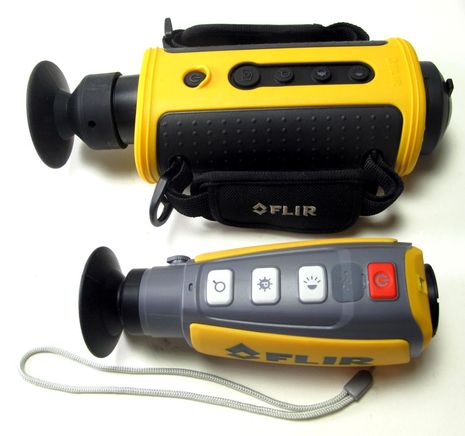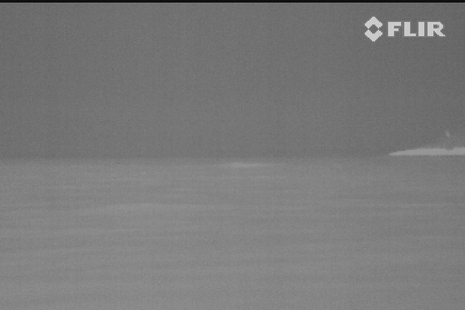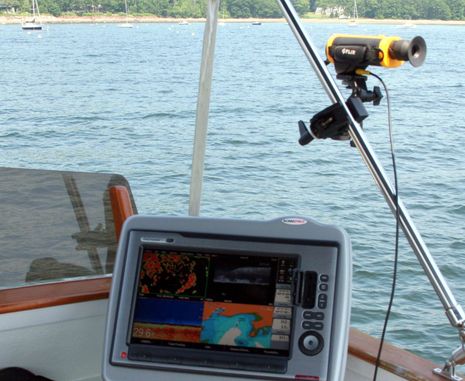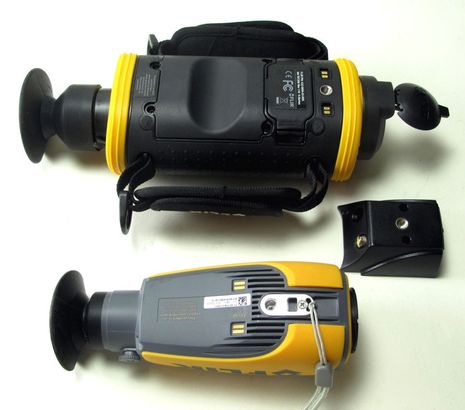First Mate MS thermal camera, FLIR does it again!

When FLIR introduced the original First Mate in late 2009, it was a breakthrough product as it was the first true marine handheld thermal camera and the base model could be had for only $3,000. Well, holy cow, check out the First Mate MS version being introduced today: it's the same core thermal technology in a much smaller package with several significant improvements and a $1,000 price reduction! But those who purchased one of the original HM models shouldn't cry just yet, as they retain a unique mode of use that you may not have even tried yet...
This is a neat product release for me because FLIR lent me both a working First Mate MS 324 and a First Mate HM 324 XP+ over a month ago. These both contain FLIR's higher resolution 320 x 240 microbolometer, so their retail prices are about $3,000 and $5,500 respectively. The MS 224 with 240 x 180 resolution will cost $2,000, and the particulars of all six HM models are laid out on this FLIR comparison page. Do note that all six come with a video output shoe. It's arguably the most important feature left out of the new MS series, as I'll discuss below, but I'll start with a camera-to-camera comparison.
Actually there's almost no comparison in hand feel. The HM series cameras are quite manageable, but the MS is almost half the weight at 12 ounces, it seems like less than half the bulk, and it has a rounded design that feels good and fits into a large pocket. The MS also starts up almost instantly while the HM takes over 30 seconds. The HM does have a standby mode once it's on, but the big change in start up time certainly suggests that the electronics in the MS are new generation. I think I also see that in the image quality. Even though both cameras have the same thermal sensor, there's a lot of processing that goes on to make that an image, and it seems like the MS delivers slightly more detail. For instance, in the screen shot below -- taken with HM 324 XP+ -- that soft whitish patch on the water surface in the middle of the frame is a slightly covered ledge, and I thought it showed a little more clearly through the MS. Of course was completely invisible without a thermal camera at night, and maybe so even during the day...

The sun-warmed stone shore of Curtis Island (to the right above) showed up blazing white hot in both cameras, though it was ink black in the ambient night light. In fact, I turned the camera's display brightness control way down to preserve my own built-in night vision, which is why that screen shot has such low contrast. Both cameras have this same control, as well as the same choice of seeing heat as white or black, but the MS adds a third choice of red. (I'm not sure yet whether I prefer red or very low brightness white in deep dark conditions.)
The MS also has the 2X digital zoom that the least expensive HM lacks and it includes a clever built-in LED flashlight that can only be switched on when the camera is off (which is when you might need it). Oh, and it's powered with a Li-Ion battery that's easily charged with a standard USB cable, while the HM series uses four AA's and a dedicated charger. Overall, I think that the First Mate MS is so much more than an incremental update to the original that it too may merit "breakthrough" status.
But what the MS series does not offer is models with the ability to capture screen shots and video, or the ability to output the camera video to a larger screen. FLIR has never made a big deal of this latter feature -- which may be because the video shoe is not waterproof like the rest of camera -- but I know that some users have made setting up a rig like I did on Gizmo a regular habit when running at night, or just when they'd like to peep around a dark anchorage. I don't fully understand the particulars of resolution and scaling -- FLIR only specs 320 x 240 resolution screen shots in the HM manual, though the 720 x 480 pixel image above is staight out of the camera -- but can tell you that it looks pretty good full or part screen on an MFD. It happened that I had a multi-jointed photography camera/light mount that works fine for this purpose, and the RCA video hook up is simple (I tried the Raymarine E Wide shown below and a Simrad NSE, but know that the Garmin 7212 and Furuno MFD12 would also support this rig)...

You might even call it a poor man's integrated thermal cam -- heck, the same microbolometer is in some models of the pan and tilt M-Series I tested, which are now also sold as the Raymarine T series, with touch screen control on E Wides like the one above. Except that even these handhelds are hard to call inexpensive, even with a 33% price reduction from HM 224 to MS 224. But right from its start in the marine world, FLIR's stated aim was to reduce the cost of thermal vision so it would become common on boats, and they deserve credit for doing their part. And of course you have to wonder what's coming next, though FLIR is always tight lipped on that score. One value improvement that it hasn't mentioned at all is a video shoe for the new First Mate MS. But it does seem possible: Note the tripod-type 1/4-20 thread socket and exterior power and video contacts on the MS below, quite like what hosts the shoe on its HM big sibling. One can hope.


 Share
Share
My wallet is starting to wiggle.